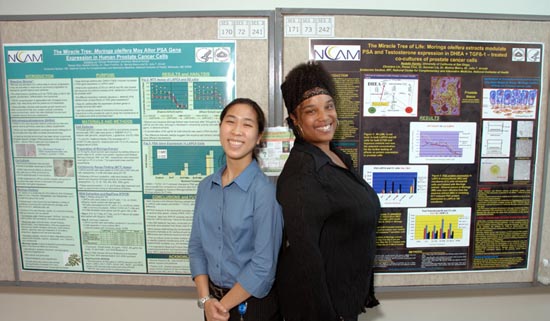| |
 |
|
|
|
|
| |
Displaying their work at Summer Research Poster Day are Christine Lin (l) and Nadelle Hamby. |
|
This summer, like any other, the students arrived like migratory birds, alighting throughout
the labs and branches, 1,600 strong. Before flying off at season’s end, many took part in an NIH rite of passage as they formally presented their results to colleagues and campus visitors.
Welcome to Summer Research Poster Day. Sponsored by the Office of Intramural Training and Education, the annual event, held in Natcher
on Aug. 7, featured the work of more than 650 summer students.
Focusing on potential applications of plant extracts in treating prostate cancer were Nadelle Hamby, a full-time EMT and a student at the University of California, San Diego; and Christine Lin, a George Washington University medical student.
“Patients are taking [natural products] without reporting it,” said Lin, “and these things need to be studied.” She and Hamby used two different extracts of Moringa oleifera, the tree formerly known as “IT” in NIH’s 2008 Earth Day contest.
Hamby was already keen on Moringa, thanks to her recent Fogarty International Center grant to study ethnobotanicals in Ghana: “We harvested
our own plants there, so taking it into the lab here was so cool.”
She found that Moringa extracts modulate prostate-
specific antigen (PSA) and testosterone expression, while Lin investigated how Moringa may alter PSA gene expression.
These were the first known laboratory uses of Moringa on human prostate cancer cells.
Both students employed a co-culture protocol, which their mentor, NCCAM’s Dr. Julia Arnold, called a new model.
“The co-culture model is something we at NCCAM are developing,” she explained, “as an important way to address how tissue microenvironment
behaves. Two important types of prostate
cells are grown together and are analyzed to determine new mechanisms of interaction and response to treatments.”
These preliminary studies allowed the lab to expand protocols for testing complex botanical agents, Arnold said.
“We loved it,” said Lin. “We came in on weekends.”
“Especially since it’s so new,” Hamby added. “Still, there’s so much we don’t know.”
The co-culture model is multifaceted. Historically,
science has reduced its investigations to the smallest possible entities, ruling out as many variables as possible.
“Science is reductionist,” Arnold said. “But when you focus your microscope too closely, you may miss something.
“Only in context,” she continued, “do these cells begin to behave the way they do in the body. We look at the whole picture. How do these cells communicate? We use a new model, and science needs to come with us.” 